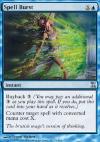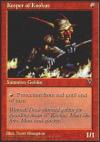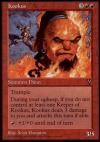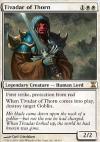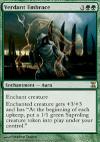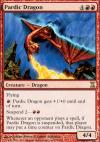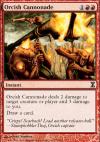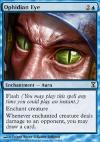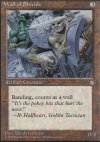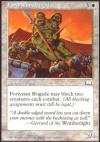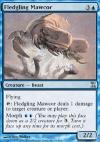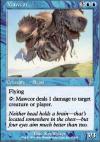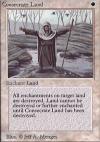|

Archive des News/Articles |
Forum Gazette |
Artgame |
MWS |
MV wiki |
Contact |
Storyline
MAJ Lorwyn éclipsé (15/12)
|
Anecdotes
Général |
OIK |
Échanges |
Règles |
Tournois |
Rumeurs |
Decks |
Vintage |
Legacy |
Modern |
Pioneer |
Standard |
Peasant |
Commander |
Tiny Leaders |
Explorer |
MTG Arena

MV anecdotes
| 4868 anecdotes trouvées |   |
La carte Spell Burst est une référence à Spell Blast de par son nom, son coût de mana et son effet.
Le texte d'ambiance de Spell Burst fait aussi écho à celui de la version Tempest de Spell Blast, et son illustration à la première illustration de Spell Burst.
Le texte d'ambiance de Spell Burst fait aussi écho à celui de la version Tempest de Spell Blast, et son illustration à la première illustration de Spell Burst.
La carte Thick-Skinned Goblin est une référence à Keeper of Kookus de par sa capacité activée et son illustration. Réciproquement, le second fait référence au premier dans son texte d'ambiance. Enfin, Keeper of Kookus fait encore référence à Kookus.
Source
Source
La carte Tivadar of Thorn est une référence à Knights of Thorn de par son nom, son effet et son illustration qui représente le même personnage avec la même épée.
La carte Unyaro Bees est une référence à Unyaro Bee Sting de par son nom, son effet et son illustration.
La carte Urza's Factory est une référence à Mishra's Factory. La capacité d'Urza's Factory est une référence au type Assembly-Worker de Mishra's Factory, mais aussi au cycle des terrains d'Urza à assembler en "Urzatron" (voir cette anecdote) qui permettent de produire sept manas au total et donc d'activer la capacité du terrain.
La carte Verdant Embrace est une référence à Verdant Force de par son nom, son effet et son illustration.
La carte Vesuvan Shapeshifter est une référence à Vesuvan Doppelganger de par son nom, son coût de mana, son effet et son illustration.
Ces deux cartes sont illustrées par Quinton Hoover.
Ces deux cartes sont illustrées par Quinton Hoover.
La carte Walk the Aeons est une référence à Time Walk de par son nom, son effet et son illustration.
La carte Weatherseed Totem est une référence à Weatherseed Treefolk de par son nom, son effet et son illustration.
Ces deux cartes sont illustrées par Heather Hudson.
Ces deux cartes sont illustrées par Heather Hudson.
La carte Wheel of Fate est une référence à Wheel of Fortune de par son nom, son effet et son illustration.
La carte Orcish Cannonade est une référence à Orcish Cannoneers de par son nom, son coût de mana et son effet.
Les cinq cartes Purelace, Thoughtlace, Deathlace, Chaoslace et Lifelace, de l'édition Limited (Alpha), forment un cycle appelé "Lace", un des premiers cycles de Magic. Les cartes Prismatic Lace et Moonlace parues ensuite font référence à ce cycle.
Ces cartes ont toutes en commun d'avoir dans leur nom le mot "lace", en français "voile", et de faire changer la couleur d'un permanent ou d'un sort. Cela fait référence au jeu de rôle "The Primal Order" de Wizards of the Coast. Dans ce jeu, les divinités peuvent "voiler" un objet ou un sort avec de l'énergie primitive, l'imprégnant d'une partie de leur propre nature divine, ce qui a inspiré le changement de couleur.
Source
Ces cartes ont toutes en commun d'avoir dans leur nom le mot "lace", en français "voile", et de faire changer la couleur d'un permanent ou d'un sort. Cela fait référence au jeu de rôle "The Primal Order" de Wizards of the Coast. Dans ce jeu, les divinités peuvent "voiler" un objet ou un sort avec de l'énergie primitive, l'imprégnant d'une partie de leur propre nature divine, ce qui a inspiré le changement de couleur.
Source
La carte Ophidian Eye est une référence à Ophidian de par son nom, son coût de mana, son effet et son illustration.
La carte Mindstab représente un Mindstab Thrull voyageant dans le temps ; elle en reprend son effet de défausse.
Cette morphologie de Thrull sera reprise pour le jeton Thrull.
Toutes ces cartes sont illustrées par Mark Tedin.
Cette morphologie de Thrull sera reprise pour le jeton Thrull.
Toutes ces cartes sont illustrées par Mark Tedin.
Les illustrations des cartes Krosan Grip et Return to Dust représentent la destruction puis l'exil d'une même épée qui est la Sword of the Meek, en référence à sa capacité récursive. Cette épée est apparue pour la première fois sur la carte Jacques le Vert.
Source
Source
La carte Ib Halfheart, Goblin Tactician représente un gobelin qui apparaît dans les textes d'ambiance de cinq cartes de l'édition Ice Age et d'une carte de Coldsnap.
• Wall of Shields
• Spoils of War
• Goblin Snowman
• Goblin Ski Patrol
• Blinking Spirit
• Panglacial Wurm
• Wall of Shields
• Spoils of War
• Goblin Snowman
• Goblin Ski Patrol
• Blinking Spirit
• Panglacial Wurm
Les cartes Foriysian Interceptor et Foriysian Totem, de l'édition Time Spiral, font référence respectivement aux cartes Foriysian Brigade et Two-Headed Giant of Foriys représentant des humains combattant des géants à deux têtes.
À l'exception de Foriysian Brigade, toutes ces cartes sont illustrées par Anson Maddocks.
À l'exception de Foriysian Brigade, toutes ces cartes sont illustrées par Anson Maddocks.
L'artiste L. A. Williams a réalisé une seconde illustration de la carte Blinking Spirit pour la 5th Edition après avoir fait la première pour l'édition Ice Age.
La carte Flickering Spirit est une référence à Blinking Spirit de par son nom, ses capacités et son illustration (voir aussi cette anecdote).
La carte Fledgling Mawcor est une référence à Mawcor de par son nom, son type de créature, ses capacités et enfin son illustration.
Ces deux cartes sont illustrées par Kev Walker.
Ces deux cartes sont illustrées par Kev Walker.
La carte Firemaw Kavu est une référence à Flametongue Kavu de par son nom, son type de créature, ses force et endurance, ses effets et enfin son illustration.
La carte Consecrate Land, illustrée par Jeff A. Menges, a fait l'objet d'une seconde illustration pour la version "time-shifted" de la carte, grandement inspirée de la première, par le même artiste, car l'illustration originale avait été perdue.
Source
Source
| 4868 anecdotes trouvées |   |





 Avatar: the Last Airbender
Avatar: the Last Airbender Spider-Man / Omenpaths
Spider-Man / Omenpaths Edge of Eternities
Edge of Eternities Final Fantasy
Final Fantasy Tarkir: Dragonstorm
Tarkir: Dragonstorm Aetherdrift
Aetherdrift Foundations
Foundations